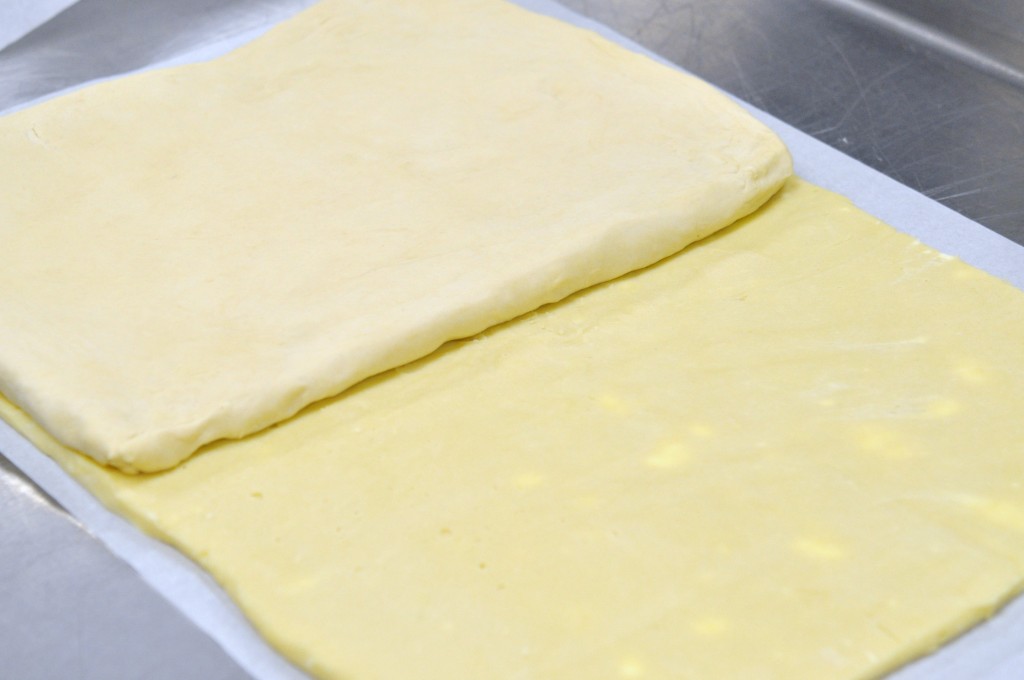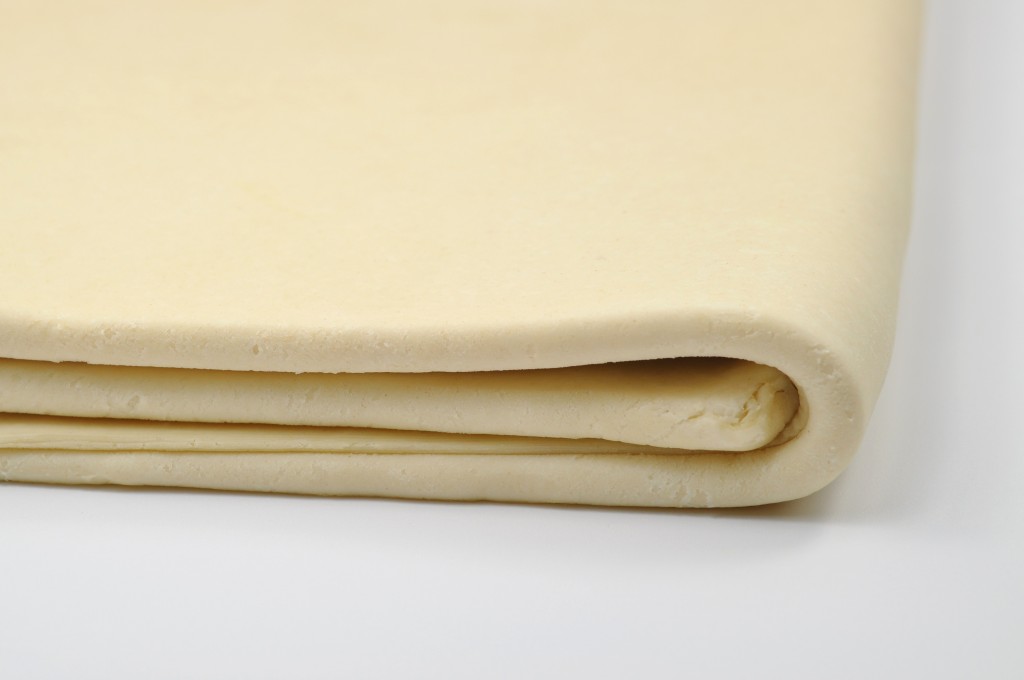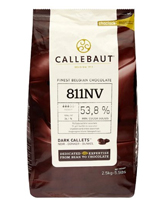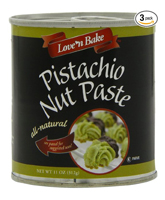Pastry Chefs have several options when it comes down to making Puff pastry and oftentimes will prepare the type which they are most familiar with or which they most prefer. Personally I have found that all types can produce excellent results when the procedure is properly followed. However based upon my research I do believe that puff pastry can differ in mouth feel. Some feel drier and some feel more buttery. Improperly made puff pastry can feel hard even though it is flaky. One thing for sure is that inverse puff pastry (Inversed or inverted puff pastry) bakes rather light and produces very flaky results. For filled applications such as apple turnovers or Pithivier I do prefer to use inverse puff pastry, reason being that it stands up real well to the steam/humidity produced from the fillings and consequently leaves virtually no traces of unbaked dough.
When preparing inverse puff pastry it is necessary to work in a cool kitchen. Instead of the butter block being wrapped by the dough it is enveloping it, thus a warm kitchen makes it nearly impossible to obtain good results. For the readers in the United States it is important to make this dough with butter labeled “European style” This type of butter contains less water and will produce better results. In other countries select butter with high fat content, this type of butter should also feel very firm in the refrigerator. Ghee or clarified butter is not recommended as some water is necessary to produce the flaky layers. Flour strengths differ around the world and thus additional flour may be needed to make the dough firm. Firm dough will create very flaky results.
Inverse Puff Pastry / Feuilletage Inverse
| 3 lb | Butter, unsalted cold | 1440 g | |
| 1 lb 5 oz | Bread flour (a) | 630 g | |
| ————————- | |||
| 2 lb 10 oz | Bread flour | 1200 g | |
| 12 oz | Butter, nearly melted | 360 g | |
| 1 lb 6 oz | Ice cold water | 660 g | |
| 1.5 oz | Salt | 45 g | |
| 0.5 oz | Vinegar | 15 g | |
In mixing bowl, fitted with the paddle attachment mix the cold butter and bread flour (a) until well combined. Dust a work surface with a small amount of flour and roll the “Butter block dough” to a sheet pan size. Cover with food wrap and place in a refrigerator for 1 -2 hours.
- Meanwhile using a dough hook, knead the remaining ingredients until well combined, approximately 2 to 3 minutes.
- Shape the dough into a half sheet pan size and cover in plastic wrap. Refrigerate for one hour.
- Place the dough on the left side of the butter block.

- Fold the right side of the butter block over the dough and press on all sides to seal.

- Place the dough with the seamless side towards you and roll the dough in the lengthwise direction 1/2” (1cm) thick. Brush off any excess flour.
- Fold the dough in thirds.

This completes a single turn. Wrap in plastic and place in refrigerator for at least one hour.
8. Position the dough with the seamless side towards you and roll the dough in the lengthwise direction 1/2” (1cm) thick. Brush of any excess flour. Fold the dough in 4 also named a book fold.
This completes a double or book fold. Wrap in plastic and refrigerate for at least one hour.
9.Repeat step 5 and 6 and refrigerate for one hour.
10. Repeat step 8 and wrap in plastic and refrigerate overnight.







This looks amazing!!! I can’t wait to try this one! Great job as always!
I have only done this before with a sheeter and am interested in trying it by hand. Love the pics, especially that first one! YUM!!
Hi Eddy,
When I have baked laminated doughs in the past (such as croissant dough or ‘rough puff’, I’ve never tried proper puff pastry), I get a lot of butter leaking out and pooling on my trays. Is this usually a result of incorrect technique in making the dough, or wrong oven temperature, or…?
Thanks,
Stuart.
It is perfectly possible to use ghee. The dough layer contains most of the water required for puffing action.
Chef Eddy,
I don’t think I made good inverse puff pastry, but I felt very happy when I saw my Alumettes having clear layers after they were baked. Inverse puff pastry has great taste and texture, I love it. Thank you, Chef
Chef Eddy,
I have heard many times that it is better to do puff pastry by hand however, I have very warm hands so would a sheeter work better for me or does it not make a difference which I use.
why does a butter with less water produce a better result as apposed to one with a higher water content?
Hi Victoria,
Butter with higher fat content will not as easily penetrate into the dough layers. Therefore it is easier to keep the butter and dough layers separate.
My best,
Eddy
i am highly intimidated by puff pastry but i also love that it has so many applications in both the savory and sweet worlds. it is definitely a treat that takes time and patients to prepare.
Working with dough can be very tasty!
I’ve always been interested in making my own puff pastry, as it is handy to have around for an aspiring baker. This recipe is comprehensive and easy to follow and the results are pretty fantastic, so thank you for posting.
This sounds like a great recipe! I did not know the long process that went into puff pastry. Like the amount of folding to get layers of gases.
You definitely have to keep the dough cold, while you are working with it. Otherwise, you don’t get as good of results in the finished process. My cooking group has made that mistake before. 🙁
This looks delicious! There is so much folding for this pastry! Is this a pastry that you you could use Chocolate Buttercream. If not, What would you eat this with?
Making puff pastry is not difficult to do, but it takes time because You have to fold it several times but in the end it worth. The only thing that I didn’t know was the amount of butter it needs, for me I thing is too much, but I learn that the butter is the one who is responsible for making the puff pastry goes up because the water in the butter makes steam.
The puff pastry was so buttery and delicious, how long can it be stored? Also what should the dough be wrapped in to store it?
this was not hard at all, but a lot of work, but at the end it was worth it and the napoleon we did came out perfect i really liked it. i used this puff pastry for a corn chowder and it came out great.
The phrase “hard work pays off” has never been so true! Making this was very time-consuming, but as long as you have something else to keep you busy, it wouldn’t be too bad to do in a professional kitchen. (It certainly is worth the work and the wait though!) I love how puff pastry is so versatile and delicious. The cheese straws we made today were so addicting, and I loved our Napoleons!